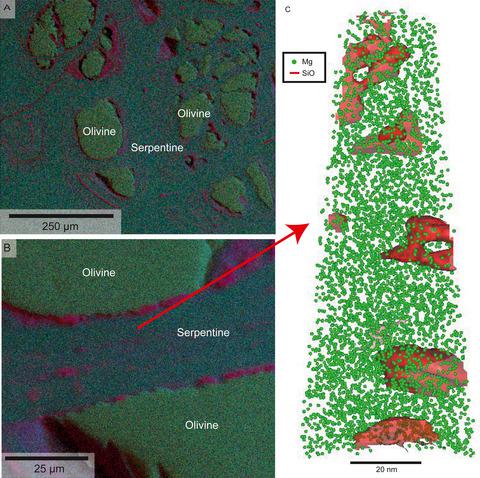当前位置:
X-MOL 学术
›
Geostand. Geoanal. Res.
›
论文详情
Our official English website, www.x-mol.net, welcomes your
feedback! (Note: you will need to create a separate account there.)
Developing Atom Probe Tomography of Phyllosilicates in Preparation for Extra-Terrestrial Sample Return
Geostandards and Geoanalytical Research ( IF 2.7 ) Pub Date : 2021-03-22 , DOI: 10.1111/ggr.12382 Luke Daly 1, 2, 3, 4 , Martin R. Lee 1 , James R. Darling 4, 5 , Ingrid McCarrol 2 , Limei Yang 2 , Julie Cairney 2, 6 , Lucy V. Forman 3, 6, 7 , Phillip.A. Bland 3 , Gretchen K. Benedix 3 , Denis Fougerouse 3, 8 , William D.A. Rickard 8 , David W. Saxey 8 , Steven M. Reddy 3, 8 , William Smith 9 , Paul A.J. Bagot 4
Geostandards and Geoanalytical Research ( IF 2.7 ) Pub Date : 2021-03-22 , DOI: 10.1111/ggr.12382 Luke Daly 1, 2, 3, 4 , Martin R. Lee 1 , James R. Darling 4, 5 , Ingrid McCarrol 2 , Limei Yang 2 , Julie Cairney 2, 6 , Lucy V. Forman 3, 6, 7 , Phillip.A. Bland 3 , Gretchen K. Benedix 3 , Denis Fougerouse 3, 8 , William D.A. Rickard 8 , David W. Saxey 8 , Steven M. Reddy 3, 8 , William Smith 9 , Paul A.J. Bagot 4
Affiliation

|
Hydrous phyllosilicate minerals, including the serpentine subgroup, are likely to be major constituents of material that will be bought back to Earth by missions to Mars and to primitive asteroids Ryugu and Bennu. Small quantities (< 60 g) of micrometre-sized, internally heterogeneous material will be available for study, requiring minimally destructive techniques. Many conventional methods are unsuitable for phyllosilicates as they are typically finely crystalline and electron beam-sensitive resulting in amorphisation and dehydration. New tools will be required for nanoscale characterisation of these precious extra-terrestrial samples. Here we test the effectiveness of atom probe tomography (APT) for this purpose. Using lizardite from the Ronda peridotite, Spain, as a terrestrial analogue, we outline an effective analytical protocol to extract nanoscale chemical and structural measurements of phyllosilicates. The potential of APT is demonstrated by the unexpected finding that the Ronda lizardite contains SiO-rich nanophases, consistent with opaline silica that formed as a by-product of the serpentinisation of olivine. Our new APT approach unlocks previously unobservable nanominerals and nanostructures within phyllosilicates owing to resolution limitations of more established imaging techniques. APT will provide unique insights into the processes and products of water/rock interaction on Earth, Mars and primitive asteroids.
中文翻译:

开发层状硅酸盐的原子探针层析成像,为地外样本返回做准备
含水层状硅酸盐矿物,包括蛇纹石亚群,很可能是火星和原始小行星 Ryugu 和 Bennu 任务将带回地球的材料的主要成分。少量(< 60 克)微米级、内部异质材料将可用于研究,需要最小的破坏性技术。许多常规方法不适用于页硅酸盐,因为它们通常是细晶且对电子束敏感,导致非晶化和脱水。这些珍贵的外星样本的纳米级表征将需要新工具。在这里,我们为此目的测试了原子探针断层扫描 (APT) 的有效性。使用来自西班牙隆达橄榄岩的蜥蜴岩作为陆地类似物,我们概述了一种有效的分析方案,以提取页硅酸盐的纳米级化学和结构测量值。Ronda 蜥蜴石含有富含 SiO 的纳米相的意外发现证明了 APT 的潜力,这与作为橄榄石蛇纹石化副产物形成的蛋白石二氧化硅一致。由于更成熟的成像技术的分辨率限制,我们的新 APT 方法解锁了以前无法观察到的页硅酸盐中的纳米矿物质和纳米结构。APT 将提供对地球、火星和原始小行星上水/岩石相互作用过程和产物的独特见解。与作为橄榄石蛇纹石化副产物形成的蛋白石二氧化硅一致。由于更成熟的成像技术的分辨率限制,我们的新 APT 方法解锁了以前无法观察到的页硅酸盐中的纳米矿物质和纳米结构。APT 将提供对地球、火星和原始小行星上水/岩石相互作用过程和产物的独特见解。与作为橄榄石蛇纹石化副产物形成的蛋白石二氧化硅一致。由于更成熟的成像技术的分辨率限制,我们的新 APT 方法解锁了以前无法观察到的页硅酸盐中的纳米矿物质和纳米结构。APT 将提供对地球、火星和原始小行星上水/岩石相互作用过程和产物的独特见解。
更新日期:2021-03-22
中文翻译:

开发层状硅酸盐的原子探针层析成像,为地外样本返回做准备
含水层状硅酸盐矿物,包括蛇纹石亚群,很可能是火星和原始小行星 Ryugu 和 Bennu 任务将带回地球的材料的主要成分。少量(< 60 克)微米级、内部异质材料将可用于研究,需要最小的破坏性技术。许多常规方法不适用于页硅酸盐,因为它们通常是细晶且对电子束敏感,导致非晶化和脱水。这些珍贵的外星样本的纳米级表征将需要新工具。在这里,我们为此目的测试了原子探针断层扫描 (APT) 的有效性。使用来自西班牙隆达橄榄岩的蜥蜴岩作为陆地类似物,我们概述了一种有效的分析方案,以提取页硅酸盐的纳米级化学和结构测量值。Ronda 蜥蜴石含有富含 SiO 的纳米相的意外发现证明了 APT 的潜力,这与作为橄榄石蛇纹石化副产物形成的蛋白石二氧化硅一致。由于更成熟的成像技术的分辨率限制,我们的新 APT 方法解锁了以前无法观察到的页硅酸盐中的纳米矿物质和纳米结构。APT 将提供对地球、火星和原始小行星上水/岩石相互作用过程和产物的独特见解。与作为橄榄石蛇纹石化副产物形成的蛋白石二氧化硅一致。由于更成熟的成像技术的分辨率限制,我们的新 APT 方法解锁了以前无法观察到的页硅酸盐中的纳米矿物质和纳米结构。APT 将提供对地球、火星和原始小行星上水/岩石相互作用过程和产物的独特见解。与作为橄榄石蛇纹石化副产物形成的蛋白石二氧化硅一致。由于更成熟的成像技术的分辨率限制,我们的新 APT 方法解锁了以前无法观察到的页硅酸盐中的纳米矿物质和纳米结构。APT 将提供对地球、火星和原始小行星上水/岩石相互作用过程和产物的独特见解。











































 京公网安备 11010802027423号
京公网安备 11010802027423号